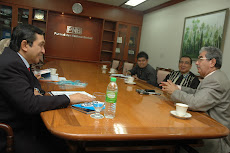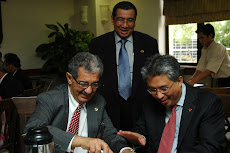Thursday, January 8, 2015
Wednesday, January 7, 2015
Naib Presiden Perdasama Datuk Naim Mohamad menerima Perlantikkan sebagai Penasihat Persatuan Orang Pekak Malaysia (Msdeaf) dan Ketua Kontinjen atau Chef de Mission ke Sukan Orang Pekak Asia Pasifik ke8 diTaoyuan, Taiwan.
Datin Seri Asmalina, Datuk Naim dan Tuan Kamarzaman
Ms Vinci Soon, Datin Seri Ismalina, Naim, Kamarzaman, Sarkunan
dan Albert Wong Tuong Chui
Mesyuarat Ahli Jawatankuasa Penyelarasan Road to Taoyuan
Friday, January 2, 2015
Floods – what now? Posted on 1 January 2015 - 08:35pm Last updated on 1 January 2015 - 11:58pm Azman Ujang
IT'S not that we don't know what causes the annual year-end floods in the East Coast, especially in Kelantan, for yet another expensive post-mortem to be conducted.
Kelantan residents' worst fear is the intensity of flooding and the ongoing floods are the most devastating in living memory.
It's traumatic to imagine how the victims will pick up the pieces of their lives with homes destroyed in a state already among the country's poorest. Government help, especially from the federal government, is on the way for them to rebuild in what could well be the biggest flood rehabilitation programme the country has ever seen.
The town of Kuala Krai, the worst affected district, for instance, was deserted with even the hospital under water and doctors and staff bending over backwards in the finest tradition of public service to save lives.
A volunteer worker, Razi Pahlavi Abdul Aziz, said the destruction in Kuala Krai was reminiscent of what he saw in Aceh 10 years ago.
"No words can express what I saw ... I feel so sad, frustrated and hopeless to see how floods can destroy a town, kampungs and the people," he said on Twitter.
So far, the floods have claimed 20 lives with 10 more reported missing. The receding waters in the last day or two fortunately saw the 200,000 victims sheltering in relief centres mostly in the state as well as in Terengganu, Pahang, Perak and Johor drastically reduced by more than half.
A senior water management expert told me the causes of the floods in Kelantan have been both natural and man-made.
The amount of rainfall last month, especially in the six days before the floods was more than double compared with December of 2013. At times some 90mm of rain was recorded within an hour – this would normally be recorded for the entire month during the non-rainy season.
Prime Minister Datuk Seri Najib Abdul Razak described the flooding as a severe catastrophe. After visiting the devastated areas he said the floods were partly caused by massive land clearing and logging. Such deforestation caused rainwater, also known as runoff water, from heavily deforested areas to flow faster into rivers, causing them to burst their banks.
To worsen the problem, floating logs also blocked the flow of water.
Kelantan Mentri Besar Datuk Ahmad Yakob blamed illegal land clearing and logging as among the causes but the expert, who spoke on condition of anonymity, said Kelantan's environmental damage was caused by both illegal and legal land clearing and logging.
"Both legal and illegal land clearing are to blame. Not adopting the best appropriate practices have led to massive soil erosion and sendimentation in rivers," he said.
According to him, there has been extensive land clearing in Kelantan in the last several years for agriculture, logging and mining while legally land has been cleared for property development and the construction of roads and highways.
He said that Kelantan is paying the price for allowing "floodways" especially along Sungai Kelantan to be reclaimed for property development. A hypermarket built on a reclaimed plot is now under water.
Reclamation effectively narrows the width of the river and drastically slows further the speed of runoff water.
Sedimentation also worsens the quality of water apart from contributing to shallow rivers and if the problem of water quality is solved, the country would be able to mitigate the flood problem as well.
Association of Water and Energy Research president S. Piarapakaran wants to know the status of flood mitigation projects carried out under the 10th Malaysia Plan of which RM5 billion was allocated. This was a marked increase from RM1.7 billion and RM3.9 billion for such programmes respectively in the previous two plans.
Kelantan was allocated RM200 million under the 10th Plan.
While the construction of flood alleviation infrastructure is vital, what's more crucial is to maintain the infrastructure. And it's obvious, our maintenence is not up to the mark.
Perhaps, we need to set up a separate department for maintenance.
According to the water management expert, whose work includes scientific studies on flood woes in Kelantan, despite the ever present threat of floods, an integrated dredging of rivers has not been carried out in the last decade.
"If forests continue to be cleared, no matter how much we spend, we will not be able to minimise the flood problem," Piarapakaran said.
The social media especially has been inundated with critical comments on the rate of land clearing in Kelantan.
One post read: "Kelantan gave vast tracts of land in the name of development to businessmen to extract timber, mining and plantation with no environmental control."
Because land is a state matter, there have also been plenty of posts urging the Kelantan government and other states not to pay lip-service to the wrath of nature.
The prime minister, perhaps, best sums it up on the lessons from this latest round of nature's fury when he said: "The Quran reminds us that human beings are the cause of devastation. God does not inflict misery on us but it is us who brought misery to ourselves."
It's obvious that flood-mitigation measures need a revamp from the viewpoint of their effectiveness.
Subscribe to:
Comments (Atom)

















































